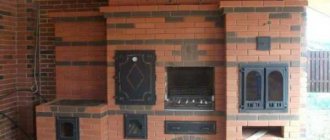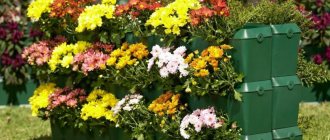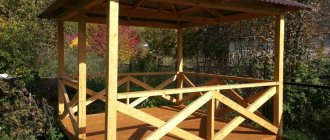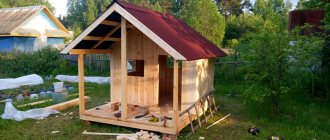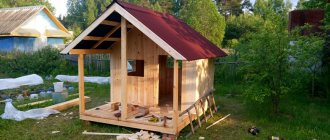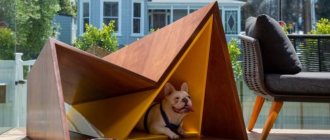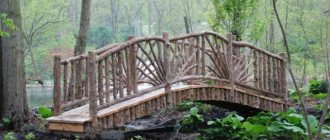Review author: Terrari School of Design
When there is a body of water on a site, whether natural or artificially created, most often the owners build a bridge across it. This attractive decorative element fits harmoniously into the natural landscape.
A decorative bridge can be made even if there is no pond. This design has a wide variety of options.
Types of bridges for the garden
There are a great variety of garden bridges; depending on the design, the following types can be distinguished:
- straight, suitable for any style of landscape design;
- the suspension bridge looks very attractive, but this masterpiece must be created in such a way that it meets safety rules;
- the zigzag garden bridge looks very original;
- stepped, looks like two stairs between which there is a platform;
- arched, one of the popular forms of bridges;
- stepwise represents a collection of individual elements.
Primary requirements
Regardless of what the garden bridge is made of, the following requirements apply to it:
- The minimum height of the crossing above the level of the reservoir should be 20 cm, so that in case of heavy rainfall the water does not reach the structure;
- The bridge must have railings - wrought iron railings, wooden gratings, rope rope;
- The structure must withstand loads of up to 300 kg.
The corresponding conditions can be contradicted if the crossing is created solely for decorative purposes. Then it is allowed to make the reservoir dry - without water. The analogue with water requires a safe depth - no more than 45 cm.
Best place for a bridge
If you place the bridge on a flat surface, it will not look organic. When there is no body of water on the site and the terrain is flat, a pond or stream for a bridge can be created artificially, as well as uneven landscapes; a bridge can be placed on one of the paths to be used.
There is an opinion that bridges look great only in large areas; this is a misconception. Made in a small size, appropriately integrated into the landscape, a bridge decorated with flowers will be a wonderful decoration even in a small area.
Under the bridge, you can make a dry stream from a string of green plants or colorful flowers. If the bridge is installed near a gazebo or recreation area, it will add additional picturesqueness to the landscape.
Landscape Design Ideas
A bridge on a garden plot should be considered as a decor that complements the appearance of the plot. Its functional purpose is revealed only when it is used to make terrain areas passable, and this rarely happens in gardens. That's why design matters.
- The presence of such decor makes a much greater impression on the audience than figurines, garden figurines, etc. And if it is combined with an artificial pond, then the garden becomes a real fairy tale (read our article on how to make a beautiful pond in your country house).
The path runs through a small ravine - the bridge made the crossing safe
- Due to the shapes and materials from which the bridge is made, you can completely transform the perception of the area on which it is installed. Its structure becomes more complex and visual space is added.
- Of course, without water features it is not easy to fit it neatly into the garden, but it is possible if you follow simple tips.
Bridge material
In order to decide on the shape and material for the bridge, it is necessary to decide what function the structure will perform and where it will be located. A bridge over a pond or dry stream is usually made of concrete, metal, stone, wood, or a combination of several materials.
The most common option for a summer house is a wooden bridge, as this is the most budget option. This is a photo of bridges for a summer house. You can buy a metal bridge ready-made, or you can make it yourself if you have the right tool.
Such a bridge looks very presentable, especially if it is decorated with ornaments. Stone and concrete bridges are not a cheap pleasure. Their main advantage is that they will look harmonious in any style of landscape design.
What to pay attention to
When choosing the most optimal model for a particular garden, you need to consider several factors that will help you make the right choice:
- General style of the garden
- Amount of free space
- Purpose of the design
If you do not plan to use the bridge for its intended purpose, you can make it from light wood. This design will be an excellent decoration, especially if there is already a wooden arch or similar objects in the garden.
Do-it-yourself country bridge
Many summer residents, wanting to make their plot of land unique with the help of decorative compositions, are wondering how to make an original bridge at the dacha? The process of creating a bridge needs to start with a drawing, which you can make yourself.
The simplest bridge model consists of stringers (the curved base of the bridge) and a deck, usually wooden. For structural strength, you can pour a strip foundation for the bridge.
Instead of a foundation, you can put wooden blocks or stones so that the product does not sink into the soil and does not deteriorate from moisture. Stringers or a base can be made of wood, metal or concrete, which should be installed on a prepared foundation. Then, make wooden flooring. The boards are laid on the base and screwed onto self-tapping screws. This is the most reliable and optimal option.
In addition to boards, flooring can be made from logs. Install balusters with railings. To install balusters, you need to measure 20-30 centimeters from the top edges of the boards. Mark the curved lines going to the bottom of the boards. Cut shallow holes along these lines with a distance of a couple of centimeters.
Using a protractor, mark the location of the balusters on the base and make holes for screws or nails. Attach the balusters to the base. The railings are also attached to the balusters with nails or screws.
Options for arranging platforms
Platforms are constructed from planed boards, which are laid on longitudinal and transverse beams fixed on piles. The role of piles that raise the platform above the ground can be performed by brick pillars or wooden beams.
The pattern of the flooring is largely determined by the size of the boards, the method of laying the strips and the dimensions of the structure being constructed. When arranging the flooring, most often the strips are laid parallel to the sides of the base.
To create the illusion of expanding the area, it is better to lay the boards diagonally: in this case, attention will focus not on the details of the structure, but on tracing the pattern
More complex compositions such as “checkerboard” or “herringbone” look advantageous in combination with surrounding textures, made in the same style.
There are often cases when the intended drawing does not give the desired effect. For example, when the platform is located between a house whose facade is made of wooden shingles and a garden path decorated with paved tiles. In such a situation, it is better to choose a flooring with a simple pattern, when the boards are laid out parallel to the sides of the platform base.
To avoid disappointment when choosing a design, designers recommend that in addition to drawing the flooring itself, you should also make a sketch of the design on tracing paper. For better visualization of the author’s ideas, the drawing and sketch should be done on the same scale.
The more sophisticated the design of the platform being constructed, the more complex the design will be of the base of the platform being built for its arrangement.
So, when drawing up a diagonal pattern, frequent installation of logs will be required. To create more complex types, you will need double logs made of solid timber, the intervals between which allow you to place an end strip.
The shape of the platform can be any:
- simple - in the form of a rectangle or square.
- complex configuration, when a multi-level structure creates a kind of cascade of open terraces.
Rectangular-shaped decks look most advantageous along the wall of the house, and square platforms are successful in a corner location between adjacent walls.
Railings are one of the key elements of the platform, giving it safety and reliability. This is especially true if the deck is being built on the shore of a reservoir.
Low partitions and openwork trellises will help provide shelter from the wind in inclement weather and provide privacy from prying eyes for rest and relaxation.
By placing floor flowerpots with flowers next to wooden fences, you can easily turn your recreation area into a blooming green oasis.
Bridges in various styles
The most common are bridges in the Japanese style, Russian (village) or avant-garde. To install a bridge in the Japanese style, it is necessary to create accompanying elements, that is, a pond or stream.
The design feature of this style is the simplicity of details and strict lines. The materials used are wood and stone. A straight wooden bridge with or without steps is a rustic style.
To make it more natural, you can use parts of tree trunks or branches as railings. Avant-garde style is characterized by a combination of materials and a predominance of arched details.
Decorative design
In order for the bridge to harmoniously “merge” into the landscape of the garden, it is necessary to determine in advance its functional features and location. It can act not only as a decorative element, but also perform a practical function. For example, (as already mentioned) to level out differences in soil, cover natural depressions, and serve as a connecting link between different parts of the site.
Healthy! There is a place for a decorative bridge in almost any garden.
After the installation of the bridge across the pond is completed, you need to take care of its decorative design. To do this, we recommend using the following examples:
- Place in the water, on one side, large boulders with rounded sides, as if sharpened by water.
- Sprinkle the approach to the bridge with colored (painted) pebbles.
- An excellent option would be a flowerbed laid out nearby or a separate tree or bush. However, do not cover it with excessive amounts of vegetation, otherwise it may lose all its aesthetic properties.
- In the dark, lamps will be an excellent, accentuating decor. For them to work, it is not necessary to stretch a light cable; it is enough to place elements powered by solar batteries.
Important! Do not overload the bridge over the pond with lamps. Select their number in accordance with the size of the structure.
Design safety
It is important that the bridge is not only stable, but also safe, especially if there are children. The best solution would be a bridge with rounded shapes without sharp corners.
Iron handrails will heat up in the sun in summer, so it is better to cover them with wooden material. The bridge must be safe to walk on.
In order for the bridge to be functional for as long as possible, it must be impregnated with special means. This applies to both wooden bridges and metal structures.
A properly treated wooden bridge will last for many years. Periodically care for the decorative structure, maintaining it in proper condition.
Bridge construction
In order for a decorative bridge to serve for a long time, it must be constructed with high quality, following a certain sequence:
- Draining the reservoir, if possible;
- Preparation of concrete supports, which serve as a kind of foundation and are located on both “shores” of one reservoir.
- Laying the span with beams on supports strictly level relative to each other and the ground surface;
- Finishing the span with plank flooring or decorative stones (in the latter case, the supporting base must be metal);
- Installation of railings.
If the structure is wooden, it can be painted. In this case, it is very important to be guided by the shape, thickness, and height of the same railing.
If they are straight, thick and low, then the design is characteristic of Asian culture. The red color completely transports you to the Land of the Rising Sun.
We recommend reading:
- Beautiful houses for a well - 115 photos of design ideas and examples of well design
How to make a hammock for a summer house: ideas and tips on how to make a simple and beautiful hammock with your own hands (120 photos and videos)
- Making a mailbox with your own hands: tips and step-by-step descriptions of how and what to make a mailbox from (95 photos)
Forging, lathing, stands with Easter roundels - all this is welcomed by traditional Europe. The color is very different - from light birch to stained oak.
There is another way to build a bridge - deepening two pairs of piles to tension the rope on which the boardwalk will be located.
In the latter, holes are made for rope wiring, which will serve as a railing. The finished bridge is original, but prone to sagging and loosening.
Interesting Facts
Natural bridges made of trees are actively used in India; this is achieved using the peculiarities of the growth of ficus rubber. Roots also grow from the trunk of this plant, which are directed into the palm trunk lying across the river. When the roots reach the opposite bank, they grow into the soil, forming a bridge.
The zigzag bridge is believed to protect household members from evil spirits.
In Xingshan County, China, a bridge was built along the river, not across it, four kilometers long.
The Norwegians built an unusual bridge designed by Leonardo da Vinci, which he designed for the Ottoman Empire. The artist’s idea, a 240-meter long bridge, was not realized at the time.
Not long ago, a bridge was built across one of the tributaries of the Amazon with a length of 3595 meters.
There is a bridge in Scotland from which dogs periodically jump and most often die. The surviving animals come to the bridge and jump off it again.
In South America, monkeys cross bridges made of spider webs.
Variety of railings
The railing is a special element of the bridge. They can be made in both simple and elaborate shapes. For example, wrapping a strong rope around the posts creates an interesting design. Imagination and creativity will help you achieve success and make your idea come true.
Bent railings will change the garden bridge. You'll have to work hard, but you'll end up with an attractive building.



